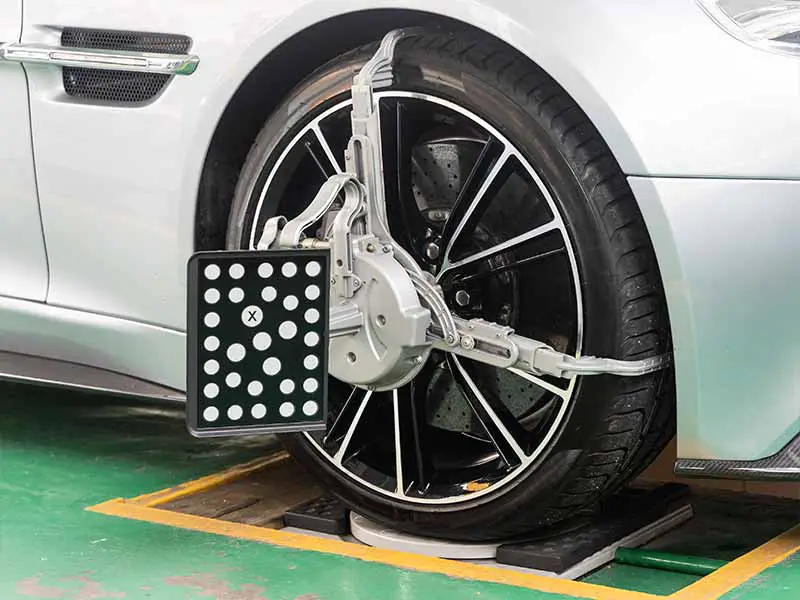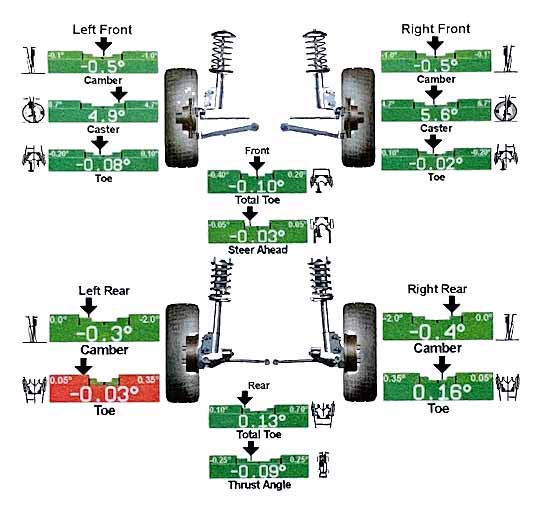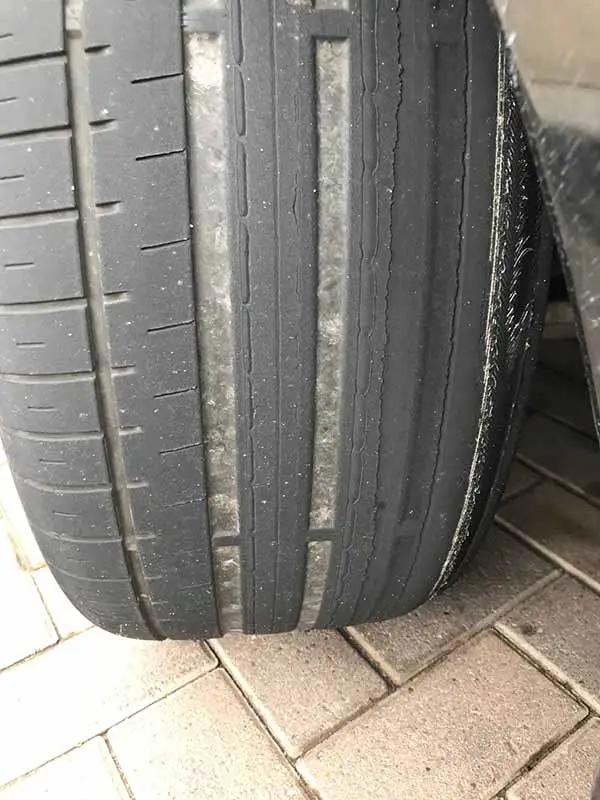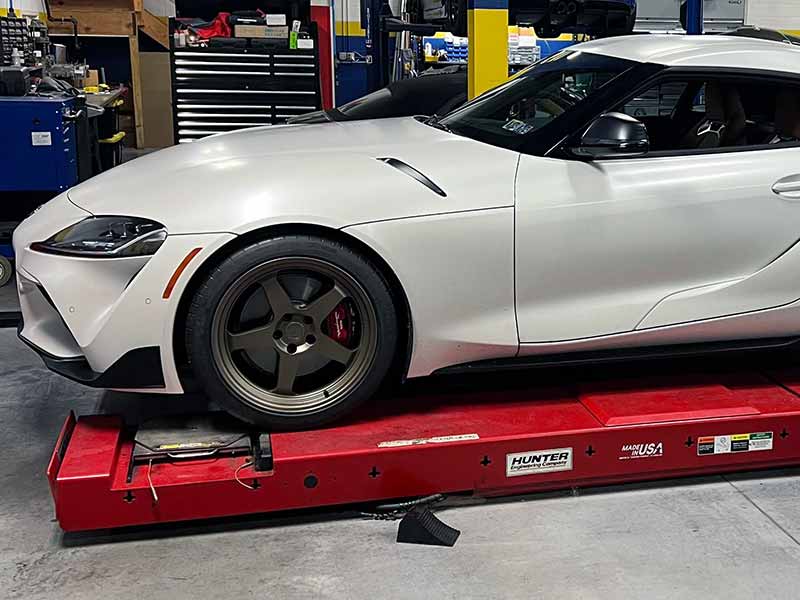You’re driving smoothly down the road, enjoying the journey, but then you notice your car starts to pull to one side, or maybe your tires are wearing out unevenly. It’s frustrating, right? That’s where understanding the importance of a 4-wheel alignment on your 2WD car comes in. It’s not just about a smooth ride; it’s about safety, efficiency, and prolonging the life of your car.
4 Wheel Alignment on 2WD Car?
Yes, a 2-wheel drive car can benefit significantly from a 4-wheel alignment. It ensures all tires wear evenly, improves handling, and maintains optimal fuel efficiency.
In this article, we’ll explore the intricacies of 4-wheel alignment for 2WD cars, discuss the signs of misalignment, compare two-wheel and four-wheel alignments, and provide expert tips on maintaining your vehicle for the best performance.

Understanding Wheel Alignment
Wheel alignment might sound like technical jargon, but it’s actually a fundamental aspect of your vehicle’s health and performance. It’s all about making sure that your tires are positioned correctly and angled for optimum contact with the road. Let’s dive into what wheel alignment entails and clarify why it’s not just for the symmetry lovers but for everyone who wants a smooth and safe driving experience.
What Is Wheel Alignment?
- Defining the Angles: Wheel alignment involves adjusting the angles of the tires which include camber (tilt inward or outward), caster (the angle of the steering pivot), and toe (the direction the tires point in relation to the centerline of the vehicle). These adjustments ensure that your tires make the right contact with the road.
- The Goal: The ultimate aim is to reduce tire wear and ensure that your vehicle travels straight and true without “pulling” to one side.
4-Wheel Alignment vs. Front-End Alignment
- 4-Wheel Alignment: This is the comprehensive adjustment of all four wheels, ensuring they are parallel to each other and perpendicular to the ground. It’s a common misconception that 4-wheel alignment is only for 4-wheel or all-wheel drive vehicles. In reality, even 2WD vehicles can benefit significantly from this type of alignment, ensuring overall stability and efficiency.
- Front-End Alignment: Typically, front-end alignment, also known as 2-wheel alignment, involves adjusting only the front wheels. This is more common in older cars where the rear axles are rigid and don’t require adjustment.
Why Consider 4-Wheel Alignment for 2WD Vehicles?
Many 2WD car and truck owners might wonder if 4-wheel alignment is overkill for their vehicles. The truth is, regardless of whether your vehicle is 2WD, 4WD, or AWD, all four wheels need to precisely interact with the road. Here’s why:
- Uniform Tire Wear: Ensuring all four wheels are aligned reduces uneven tire wear, extending tire life.
- Improved Handling: Correct alignment means better handling and a smoother ride, as the car won’t pull to one side.
- Safety and Efficiency: Properly aligned wheels can improve fuel efficiency and make your vehicle safer to drive.
To get a foundational understanding of tire alignment and its impact, take a look at this detailed article on What is Tire Alignment?. It’s packed with insights that clear up common misconceptions and provide you with the knowledge to make informed decisions about your vehicle’s maintenance.
Benefits of 4-Wheel Alignment for 2WD Vehicles
Understanding the tangible benefits of 4-wheel alignment for your 2WD car or truck is like unlocking a new level of vehicle maintenance that can save you money and enhance your driving experience. Here’s how a properly aligned vehicle can make a real difference:
Extended Tire Life
- Even Wear: Misalignment can lead to uneven tire wear, with some parts wearing out faster than others. A 4-wheel alignment ensures that all tires wear evenly, extending their life.
- Cost Savings: Longer-lasting tires mean you’ll save money in the long run, as you won’t need to replace them as frequently.
Improved Fuel Efficiency
- Reduced Resistance: Proper alignment decreases rolling resistance, which means your car won’t have to work as hard or burn as much fuel to move forward.
- Greener Driving: Not only does this save you money at the pump, but it also reduces your carbon footprint.
Enhanced Safety and Handling
- Predictable Steering: When your car is properly aligned, it will have more stable and predictable steering. This is crucial for maintaining control during sudden maneuvers or in bad road conditions.
- Smooth Ride: A well-aligned car drives smoother, providing a more comfortable ride and reducing driver fatigue.
Prolonged Vehicle Life
- Less Stress on Components: Alignment issues can put extra stress on various parts of your car, including the suspension and steering systems. By keeping everything aligned, you reduce this stress and prevent premature wear and tear.
- Preventative Care: Regular alignment checks and adjustments can catch and address small issues before they turn into costly repairs.
To understand how often your vehicle might need this kind of attention, consider reading about the recommended frequency for alignment checks in How Often Should You Get an Alignment?. Staying informed helps you maintain the optimal schedule for your car’s needs.

Comparing Two-Wheel and Four-Wheel Alignments
When it comes to wheel alignments, knowing the difference between two-wheel and four-wheel services is key to making informed decisions for your vehicle’s care. Let’s break down the distinctions and discuss why even 2WD vehicles can benefit from the comprehensive approach of a four-wheel alignment.
Two-Wheel Alignment: The Basics
- Front-End Focus: Two-wheel alignments typically involve adjusting only the front tires. This is often sufficient for older vehicles with a rigid rear axle that doesn’t require adjustment.
- Adjustments Made: The service usually includes adjusting the camber, caster, and toe of the front wheels to ensure they are properly aligned with the centerline of the vehicle.
Four-Wheel Alignment: A Comprehensive Approach
- All-Around Precision: Four-wheel alignments adjust all four tires, ensuring they are parallel to each other and perpendicular to the ground. This is crucial for modern vehicles where both the front and rear suspensions are adjustable.
- Benefits for 2WD: Even if a vehicle is 2WD, aligning all four wheels ensures that the vehicle drives straight and true. This is especially important for cars with independent rear suspension systems.
Key Differences and Considerations
- Scope of Service: The primary difference is the scope. Two-wheel alignments adjust only the front, while four-wheel alignments encompass all tires.
- Vehicle Type and Age: Generally, older vehicles with non-adjustable rear axles might only need a two-wheel alignment, while most modern vehicles benefit from four-wheel alignments.
- Cost and Time: A four-wheel alignment might cost more and take a bit longer than a two-wheel alignment, but the benefits of improved tire life, fuel efficiency, and safety can outweigh these factors.
Why Opt for Four-Wheel Alignment?
Choosing a four-wheel alignment for your 2WD vehicle isn’t just about following best practices; it’s about ensuring optimal performance and longevity. Here’s why it makes sense:
- Comprehensive Care: It addresses the entire vehicle’s alignment, not just the part that steers.
- Preventive Maintenance: Helps identify and rectify rear alignment issues that could affect tire wear and handling, even in 2WD vehicles.
- Long-Term Savings: By extending tire life and improving fuel efficiency, the initial higher cost can lead to savings down the road.
For those curious about the implications of tire replacement on alignment, consider exploring the nuances of why and when to align your wheels in Do I Need an Alignment After Replacing Tires?. It’s an essential read, especially after investing in a new set of tires.

Signs of Misalignment in 2WD Vehicles
Recognizing the early signs of misalignment can save you from a host of problems down the road, from premature tire wear to compromised safety. Here’s what you need to keep an eye out for in your 2WD car or truck to determine if it’s time for a wheel alignment.
Uneven or Rapid Tire Wear
- Outer or Inner Wear: If the inner or outer edges of your tires are wearing down faster than the rest, it might indicate camber misalignment.
- Patchy Wear: Uneven wear patterns, such as bald spots or high and low areas, often suggest issues with toe alignment.
Steering Issues
- Pulling to One Side: If your vehicle drifts to the left or right even when you’re driving on a straight, level road, it’s a classic sign of alignment problems.
- Off-Center Steering Wheel: When you’re driving straight, but your steering wheel isn’t centered, it’s time to get the alignment checked.
Driving Discomfort
- Vibration: Unusual vibrations in the steering wheel or throughout the vehicle can be due to misaligned wheels.
- Handling Difficulties: If your vehicle doesn’t handle tight turns or react as nimbly as it should, the wheel alignment could be off.
Why These Signs Matter
Ignoring these warning signs can lead to increased tire wear, reduced fuel efficiency, and a less safe driving experience. It’s not just about comfort; it’s about preventing more significant issues and expenses in the future.
- Preventive Action: Regularly inspecting your tires for these signs and acting promptly can help ensure longer tire life, better performance, and more enjoyable driving.
- Professional Insight: If you notice any of these signs, it’s often best to consult with a professional who can perform a thorough alignment check and make the necessary adjustments.
Understanding the frequency of needed alignments is crucial to vehicle maintenance. Take a moment to learn about how often you should get an alignment to keep your 2WD vehicle running smoothly and safely.
Resources
Below are some links you may find helpful when learning about tires:
- How often should I get my alignment checked per year? – Les Schwab
- What’s the difference between a two-wheel and four-wheel alignment? – Firestone
Final Thoughts
Ensuring your 2WD vehicle undergoes regular 4-wheel alignment is not just about keeping your ride smooth; it’s a critical component of vehicle maintenance that impacts safety, performance, and cost efficiency.
Regular alignment checks prevent uneven tire wear, improve fuel efficiency, and enhance your driving experience.
By understanding the signs of misalignment and seeking professional service when needed, you can maintain your vehicle’s health and ensure a safer, more enjoyable driving experience.
Good luck and happy motoring.





